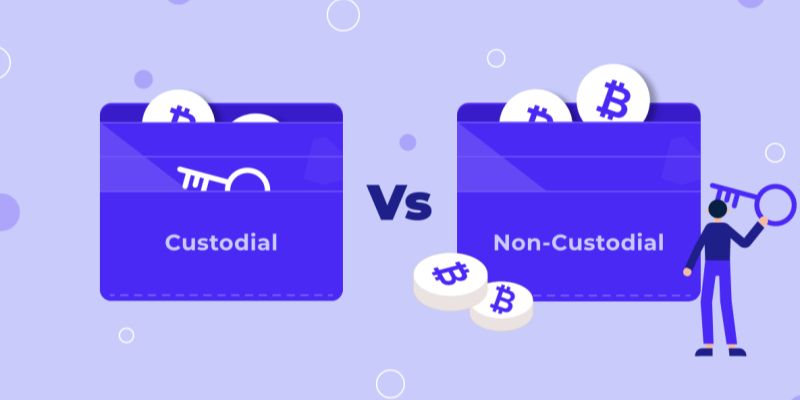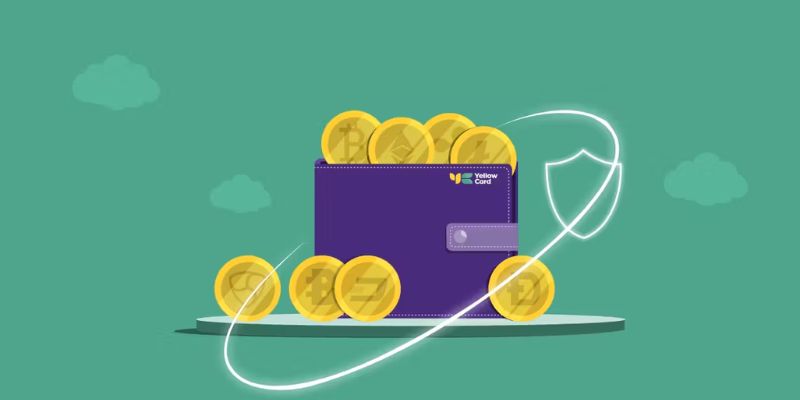In the world of crypto, Custodial vs Non-Custodial Wallets: Securing Your Crypto Smarter can feel like a tightrope walk above a digital abyss. Get it wrong, and you could watch your digital gold vanish into the cloud. But I’ve got your back! Today, we cut through the jargon to unpack custodial vs non-custodial wallets (and how to create each), simplifying the complex so you can make choices that secure your cyber treasure like a pro. Ready to become a crypto whiz? Let’s dive into the essentials of crypto wallet security and setup, empowering you with the know-how to guard your assets with confidence.
Understanding the Fundamentals of Crypto Wallets
Exploring the Differences: Custodial vs Non-Custodial Wallets
Let’s dive into wallet types. You’ve got two main kinds: custodial and non-custodial. Think of custodial wallets like a bank. They keep your crypto for you. They manage the private keys, and you access your funds through them. Non-custodial wallets put you in charge. You control the keys and the crypto.
Choosing a wallet type is big. What’s right for you? Custodial wallets are simple and user-friendly. Great for beginners. But, your crypto lies in someone else’s hands. If they get attacked, your funds are at risk. Non-custodial wallets give you more control and less risk of theft from hacks targeting the custody provider. But, they need more know-how to use safely.
Setting up these wallets is different for each. Here’s how.
The Basics of Wallet Security
Got your wallet picked out? Great. Now, let’s secure it. For any wallet, a strong, unique password is a must. Write it down where no one can find it but you. Then, we’ve got two-factor authentication (2FA). This is like a double lock on your crypto. Use it.
Now, let’s talk about backups. Your non-custodial wallet has a seed phrase. It’s a bunch of random words that can bring back your wallet if you lose it. Like a magic key. You must keep this secret and safe – if someone gets it, they can steal all your crypto. Custodial wallets usually don’t have this, since the provider has the keys.
Multi-signature wallets need more than one key to use your crypto. This spreads risk and can keep your funds safer. Think teamwork for security.
Keep your wallet software updated, always. This gives you the latest protection against bad actors. For extra safety, use hardware wallets. They store your crypto offline, away from online threats.
Remember to compare wallet providers too. Look at their security track record, customer support, and what other users say. Trust is key when you’re choosing where to store your crypto.
Now you’ve got the basics. Next up, we’ll tackle how to set up your chosen wallet and keep those digital treasures all locked up tight.
Setting Up Your Wallet: A Step-by-Step Guide
How to Create a Custodial Wallet
Think custodial wallets like a bank. They keep your crypto safe. You trust someone else with it. First, pick a trusted crypto wallet provider. Look for one with strong security and good reviews. Go to their site or app. Make an account. Use a strong password you won’t forget. They might ask for an ID or selfie to keep your account safe. Some call this KYC, or Know Your Customer. It’s like making sure it’s really you.
Now, your account needs a safety net. Set up two-factor authentication, or 2FA. This sends a code to your phone or email when you log in. No one gets in without this code. Your wallet is now ready! Remember, the provider has your keys. They take care of them, so you don’t have to. But this means they also control your crypto. If they have issues, your crypto could be stuck.
Steps to Establish a Non-Custodial Wallet
A non-custodial wallet gives you all the power. You’re the boss. No middleman. You hold your keys, like a treasure map you keep safe. First, choose a non-custodial wallet type. Think about what fits your life. Online, on your phone, or a piece of hardware? Now, onto non-custodial wallet creation steps! Here we go!
Download the wallet app or buy a hardware wallet. Both come from trusted sources. For software, get it from the official store or site. For hardware, buy new, not used. You want it clean from the start. Open the wallet app or plug in the device. Follow the setup. Write down your seed phrase on paper. Not on your computer or phone. Your seed phrase is like a master key. It opens everything. Keep it safe, like in a safe!
With your seed phrase stored, your wallet’s ready. Send some crypto in or out to test it. Make sure you can do it right. Keeping your wallet secure is on you. No one else will fix it if you make a mistake. Always double-check addresses before you send crypto. A wrong move can’t be undone.
Both wallet types have pros and cons. Choose a crypto wallet that fits how you use your crypto. Some want the ease of a custodial wallet. You log in and it’s all there, no extra steps. Others like the control a non-custodial wallet gives. Yes, more work. But also more peace of mind.
Secure cryptocurrency storage matters. In a custodial wallet, you trust the wallet provider to keep your crypto safe. But in a non-custodial wallet, you manage everything. This means taking care of wallet private keys management. You learn the blockchain wallet mechanisms to keep your crypto safe.
Always, always keep your private key and seed phrase safe. Losing them is like losing your crypto forever. No one can get it back for you. Not even with cryptocurrency wallet insurance or crypto asset recovery options.
There are more bits and bobs to know, but these are the steps to start. Get deeper into the world of crypto wallets after you nail these basics. It’s about finding the right balance of safety, control, and ease. Happy crypto storing!
Mastering Wallet Security and Management
Key Security Features for Protecting Your Crypto Assets
In crypto, how you store your coins is key. Like a digital Fort Knox, your wallet’s got to have top-notch security to keep hackers out. Why’s this so big? Because once your crypto’s stolen, getting it back is near impossible. Now, what are these key features you need in a wallet? Think about tough passwords, something only you know. Use two-factor authentication (2FA) so even if someone guesses your password, they’d still need a special code to get in.
Multi-signature protection is another layer. It’s like having multiple keys to a treasure chest. More keys mean it’s harder for thieves to open. It’s a no-brainer that you want these features in whatever wallet type you choose. They work in both hot wallets, which are online, and cold wallets, offline, like USB security key kind of gadgets.
Best Practices for Managing Wallet Private Keys and Seed Phrases
Let’s chat about keys and seed phrases. A private key is like the key to your house; you don’t want to lose it or hand it over to a stranger. Write down your seed phrases – these are your backup keys. Keep them in a safe spot where only you can get to them. Never, ever share them online. If you’re using a custodial wallet, the service keeps your keys.
It’s like they’re holding onto your house keys for you. With non-custodial wallets, you’re in full control, holding onto your keys with no one else having access. Now, for setting up a wallet, you first pick if you want a custodial or non-custodial one. Then you find a wallet provider that fits what you need and follow their setup guide or creation steps. This might mean downloading software or buying a hardware device, depending on the wallet type.
Getting back to seed phrases, they’re the master key. If your wallet gets lost or broken, those words can restore it. So, you write them down in order and lock it up good. The best practice is to have a few secure places where only those you trust know about them. But remember, losing these is like losing your entire crypto stash. Treat them like gold.
For both custodial and non-custodial wallets, encryption is your friend. It scrambles your info so that snoops can’t just look at your stuff and know what they’re seeing. Good wallet providers will have strong encryption already, but always check before you pick one.
Always keep learning about new ways to secure your crypto. Security’s never a one-and-done deal; it’s an ongoing battle to stay ahead of the bad guys. So, stay sharp, and don’t let them catch you off guard. Remember, in the world of crypto, your security habits can make or break your digital fortune. Choose smart and stay safe, friends!
Evaluating Wallet Types for Informed Decision Making
Comparing Hot Wallet vs Cold Wallet Benefits
Hot wallets connect to the internet and give you quick access to your crypto. Cold wallets do not. They store your coins offline. This makes them safer from hackers.
Think of a hot wallet like cash in your pocket. It’s easy to use, right? But easy to lose too. Now, think of a cold wallet. It’s like a safe in your home. Harder to get, but much safer.
Both have their uses. For everyday spending, a hot wallet shines. But, for saving big amounts, a cold wallet is best.
Regulatory and Recovery Aspects of Crypto Wallets
Crypto wallet rules differ around the world. In some places, they’re pretty strict. In others, not so much. This can affect how you get your money back if things go bad.
With a custodial wallet, the service holds your keys. If they mess up, you might get help. But in a non-custodial wallet, you’re the boss. If you slip up, like losing your keys or seed phrase, it can be tough. Often, no one can help you get your crypto back.
Backup and recovery options are a must. With hot wallets, use strong passwords and two-factor authentication. With cold wallets, keep backups of your keys or seed phrases. And keep them safe, like in a bank vault or a secret spot at home.
Both wallet types have strengths and risks. By understanding them, you make smarter choices. Remember, in the crypto world, security is always key!
We’ve just walked through the nuts and bolts of crypto wallets, from their basic types to how you can create one safely. Whether it’s picking between a custodial or non-custodial wallet, or choosing hot versus cold storage, knowing these details is crucial. You’ve learned how important security features are and the best ways to handle your private keys and seed phrases.
Remember, a big part of staying safe with crypto is being informed and careful. Each wallet has its own pros, cons, and uses, so think about what you need before making a choice. Keep up with rules and know how to get your crypto back if needed. I’ve given my knowledge here so you can step into the crypto space with confidence. Make smart choices and keep your digital coins safe!
Q&A :
What is the difference between a custodial and non-custodial wallet?
Custodial wallets are provided by a third party that maintains the private keys of the wallet on your behalf. This means that the service provider has the ultimate control over the funds in the wallet. In contrast, non-custodial wallets place the responsibility of safeguarding the private keys directly in the hands of the user, giving them full control over their assets.
How do you set up a custodial wallet?
To create a custodial wallet, you need to sign up with a service that offers custodial wallet services. This typically involves providing personal information and verifying your identity to comply with regulatory requirements. Once your account is set up, the service will maintain your wallet’s private keys, and you can access your funds using their web interface, mobile app, or other provided tools.
What are the steps to create a non-custodial wallet?
Setting up a non-custodial wallet usually involves the following steps:
- Download and install a reputable non-custodial wallet app or software.
- Securely generate and record your wallet’s private keys or recovery phrase (usually shown only once during setup for security reasons).
- Follow the app’s instructions to finalize the setup process.
- Ensure your private keys or recovery phrase are stored safely in a location only you can access.
Which one is safer: custodial or non-custodial wallets?
The safety of custodial and non-custodial wallets depends on different factors. Non-custodial wallets are considered safer in terms of users having full control over their private keys, reducing the risk of service provider breaches. However, the user must be vigilant about security practices. On the other hand, custodial wallets might be less risky for users who are not confident in their ability to secure their private keys, as the provider takes on the security responsibilities.
Can I switch from a custodial to a non-custodial wallet?
Yes, you can switch from a custodial to a non-custodial wallet. To do this, you will need to set up a non-custodial wallet and transfer your assets from the custodial service to the new wallet’s address. Ensure that all safety precautions are taken during this process to protect your funds.






